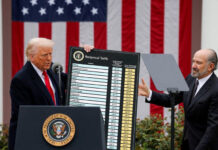DECEMBER 12, 2023

The biggest driver behind cheaper gas is falling oil prices. – Maansi Srivastava/TNYT
In the fight to bring down inflation, the falling price of gasoline stands out as a victory, even if Federal Reserve policy has little to do with it.
The national average for unleaded gas was $3.14 a gallon on Dec. 12, according to AAA. That’s 23 cents less than it was a month ago and the lowest it has been in nearly a year. Higher prices in California, where gas is $4.70 a gallon, may be masking a more broad-based decline: About 60 percent of gas stations are selling below $3 a gallon, AAA says, and a quarter are below $2.75.
The fall in gas prices has been crucial to an overall slowdown in inflation. On Tuesday, the government reported that the Consumer Price Index rose 3.1 percent in November, from a year earlier. Gas prices fell 5.8 percent month over month in November, the index showed, following a 4.9 percent drop in October.
The biggest driver behind cheaper gas is falling oil prices. The price of Brent crude, the international benchmark, had plunged to $69 a barrel by midday Tuesday, after approaching $100 a barrel in late September.
Gas prices usually start abating in the fall, as most states switch to a cheaper blend of fuel that contains more butane. Demand also drops after the summer, which is peak driving season in the United States.
There’s reason to think that prices might continue to decline. A key reason is the unusually warm winter that’s depressing demand for home heating fuel, said Tom Kloza, global head of energy analysis at Oil Price Information Service. Mr. Kloza predicts the average cost of gas will fall past last year’s low point, $3.10, and below $3 per gallon by the end of the month.
“Mother Nature has clearly done a favor for consumers,” Mr. Kloza said. He cautioned that warmer weather in the Northern Hemisphere will drive up the price of crude starting in February, as it typically does.
Higher gas prices are a burden for consumers, particularly for lower-income Americans who spend a high share of their income on fuel, and a headache for elected officials whose approval ratings can be linked to how much consumers pay at the pump. They have also been one of the starkest symbols of high inflation for the past two years: The average price of gas rose above $5 per gallon in June 2022, when overall inflation reached 9 percent.
The Fed’s preferred measure of inflation does not consider volatile prices like those for fuel, and economists tend to play down gas prices when looking at structural inflation. Oil prices are largely determined by geopolitics and the whims of foreign markets, though the president has the power to exert some deflationary pressure by tapping the Strategic Petroleum Reserve, the nation’s emergency supply of crude.
Gas prices are nonetheless top of mind for Americans, particularly when it comes to forming their opinions of the economy and elected leaders.
Research from Carola Binder, an economics professor at Haverford College, has found that consumer sentiment becomes significantly more pessimistic when gas prices are higher, and that Americans view soaring gas prices as a negative portent for the economy as a whole. In turn, gas prices are also tied to presidential approval, according to political science research.
The fall in gas prices has come as consumer sentiment has rebounded, although it remains below prepandemic levels. According to the University of Michigan’s survey, a closely watched indicator, consumer sentiment in December shot up 13 percent compared with the previous month. Overall, consumer sentiment is nearly 40 percent higher than in June 2022, the lowest in the survey’s history, when gas prices last reached $5 a gallon and inflation was at a four-decade high.
Courtesy: NY Times








































































































